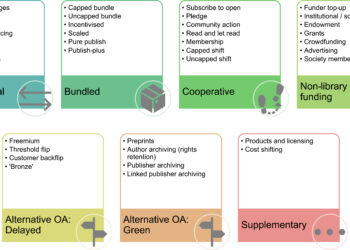
- Image via Wikipedia
A venerable Open Access title in medical research has instituted a subscription model for its online journal.
The Journal of Clinical Investigation (JCI), a prestigious title in continuous publication since 1924, implemented a subscription model beginning with its January 2009 issue. Original articles, however, continue to be freely available.
JCI began providing free access to all online content in 1996. In spite of dwindling revenue from print subscribers, the journal continued to justify free access to its content.
JCI has an impact factor of 16.9, and is the most highly-cited journal within its category of Medicine, Research and Experimental, according to ISI’s 2007 Journal Citation Reports. Its editors reject 9 out of every 10 manuscript submissions.
The journal receives several sources of income from its authors. JCI charges for submission ($70 US), pages charges ($0.22 per word), plus additional fees for each figure ($100), table ($50), supplemental data ($300) and color ($1000). Apparently, these author charges are not sufficient to cover publication costs for a high-quality journal.
Between 1996 and 2003, JCI lost 40% of its institutional subscribers, according to John Hawley, Executive Director of the American Society for Clinical Investigation. Responding to my email on his decision to institute online subscriptions, Hawley responded in practical terms:
The decision to institute access control was not a strained one; there are costs to be met, and this was the one route available to determine if they could be met.
In 2005, another prestigious medical journal, the British Medical Journal (BMJ), ended full free online access, citing hemorrhaging revenue and the desire to fund future product development as justifications. BMJ (like JCI) still provides free access to research articles.
There is a substantial difference between these two journals: BMJ publishes only 4 or 5 research articles per issue — the rest is full of editorials, letters, news, commentary, and other non-research material. In comparison, JCI is primarily a research journal, publishing 15-30 articles per issue with little non-research material. Responding to a question I posted on MEDLIB-L, a listserv for medical librarians, Peter Cole, director of the Aquinas Medical Library in New Jersey responded:
there isn’t enough non-research content in JCI to justify purchasing a subscription
Other librarians responded that they reinstated their institutional subscription, some begrudgingly. At a time when many librarians are attempting to make radical cuts in their budget, this news did not come at a welcome time. Leslie Czechowski, Assistant Director of Collections & Technical Services at the University of Pittsburgh Health Sciences Library responded:
we canceled [our subscription] because of free online access. Another year we might have resubscribed, but in times of declining budgets, it will be a more difficult decision
If new subscription revenue does not meet expectations, does JCI have any recourse (such as increasing page fees for authors)? John Hawley answered soberly,
There’s always recourse.
Discussion
5 Thoughts on "End of Free Access"
For what it’s worth, here’s the nonredacted version of my responses to the queries provided to me:
* How difficult was it to make this decision?
The JCI instituted access control for most non-research articles (commentaries, reviews, etc.) in January 2009. The history of the JCI publishing a mass of these types of articles is relatively brief, the last decade or so. While access control for this content was discussed in the past, the sentiment was that if the JCI could afford to make this content freely available, it should. This sentiment, however, progressively came up against hard costs — staffing, printing, and the like — for which there was no offsetting revenue such as there has been for the research articles published in the JCI. The decision to institute access control was not a strained one; there are costs to be met, and this was the one route available to determine if they could be met.
* Do you think there enough incentive for libraries to reinstate their subscriptions. Put another way, do you think there enough content outside the original research articles to demand a subscription?
We hope to bring back former institutional and individual subscribers, certainly. We feel that the articles we’re publishing are of standout quality, produced typically by leaders in their given fields. The metrics from citation rates to online usage suggest we’re hitting the mark. If quality isn’t a sufficient draw, it’s a problem not just for the JCI but many other journals.
* Considering the current financial market, will libraries have the leeway to reinstate subscriptions?
The economic climate for libraries has been eroding for some time, thanks to the avarice and near monopoly of commercial publishers. As a nonprofit publisher, I believe our role — our obligation — is to deliver the best journal we can at the lowest cost possible. We’ve done this; whether libraries can turn down the big deal to come back to us (and other nonprofit publications) remains to be seen.
* If new subscription revenue does not meet expectations, is there any recourse (e.g. increase submission fees, page fees, etc.)
There’s always a recourse.
![Reblog this post [with Zemanta]](http://img.zemanta.com/reblog_e.png?x-id=c51cbd5f-5b2b-453d-b4ae-cc1781d96521)


